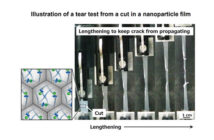A research team from the University of Tennessee, Knoxville, Eastman and Flexsys in the USA have developed a new method which can ensure consistency and quality in rubber manufacturing as well as have a real-world impact on material sustainability and durability for products including car tires.
The team, which consists of University of Tennessee Professor Fred Peebles, IAMM Chair of Excellence Dayakar Penumadu, electrical engineering graduate student Jun-Cheng Chin, postdoctoral researcher Stephen Young, two Flexsys scientists and one Eastman scientist, published research which identified flaws in rubber materials, one of the industry’s most common production challenges.
Additives including zinc oxide and sulfur are added to rubber compounds to improve strength, elasticity and other attributes necessary for producing high-performing tires. If these ingredients are not distributed evenly when producing a rubber mix for a car tire for example, then the material will degrade prematurely.
“If components such as sulfur do not disperse well, that generates localized hard spots,” said Penumadu. “That hard stuff attracts a lot of mechanical and thermal stresses, making the material degrade prematurely.”
Through research the team found that flaws as small as the width of a human hair can have a significant impact on the lifespan of car tires. By identifying and studying these, engineers can understand how a material will perform before a problem with the product occurs.
“The current industry approach is to cut out a small sample of rubber, then observe it under an optical microscope,” commented Penumadu. “Not only is this tedious and destructive, but it’s also unreliable. It requires you to guess beforehand where, in an opaque sample, you need to check for inconsistencies.”
These optical microscopes are also unable to identify the difference between rubber components, as both sulfur and zinc oxide appear as white specks under the microscope.
To overcome this issue, Penumadu and the team use x-ray computed tomography (XCT) instead of conventional optical analysis. This method makes use of x-rays which are passed through a sample and are scattered and absorbed differently depending on the materials they hit. A digital 3D model is then produced by a computer of the rubber’s interior make up.
“This is a very important point,” explained Penumadu. “XCT lets us see the inside of the material non-invasively, and we can actually see the distribution of each component.”
By using this new method, manufacturers and engineers or scientists within the rubber industry will be able to view and predict flaws within products such as tires. This will enable more consistent and higher quality rubber products and materials to be produced, extending their service life.




